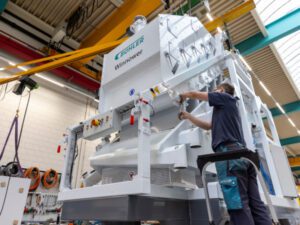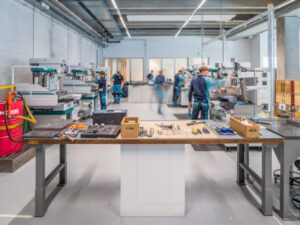Volker Guennel shares how innovation can help producers meet rising demands for efficiency, sustainability and flexibility
At the recent bakery and confectionery trade fair, iba, in Düsseldorf, International Confectionery Editor Joseph Clarke had the opportunity to sit down with Volker Guennel, Director of Sales and Marketing at CHOCOTECH.
Set against the backdrop of an industry evolving to meet shifting consumer preferences, tightening regulations, and growing calls for sustainability, the conversation touched on some of the most critical themes shaping the future of confectionery manufacturing. From the integration of clean-label demands and active ingredients to the pressing need for energy-efficient solutions and intuitive automation, Guennel shared his insights on how CHOCOTECH is responding to a changing landscape.
As manufacturing becomes more complex and competitive, and expectations for flexibility, traceability and quality intensify, confectionery manufacturers are tasked not only with refining traditional processes but also with anticipating the future needs of both producers and consumers.
In this interview, Guennel discusses the key technology trends, sustainability initiatives, and operational challenges driving the confectionery sector forward—and how CHOCOTECH is helping manufacturers adapt, innovate, and thrive.
What are the most significant technology trends you’re observing in the confectionery manufacturing sector, and how are they reshaping production lines?
In general, we’re in a position where we need to deliver equipment that can produce traditional confectionery products—but in a far more efficient way. Many of these products have been around for over 5000 or even 6,000 years, depending on how you trace their origins. This longevity means there’s little room to modify the end product itself, whether in texture, flavour, or formulation.
So, the challenge becomes one of process optimisation. We’re developing machinery that is CIP-capable (Clean-In-Place), energy-saving, and operator-friendly, allowing confectioners to produce legacy products with much greater efficiency. The focus is on maintaining product consistency while enhancing throughput, hygiene, and operational simplicity.
How is the growing demand for healthier confectionery influencing the design and operation of equipment?
The demand for healthier options—such as over-the-counter (OTC) confectionery with active ingredients—is having a significant impact. We now need to incorporate more advanced technology into our equipment. That includes precise measuring instrumentation, weight control systems, and real-time product quality monitoring.
Whereas our standard equipment used to cover about 70 to 80% of production needs, we now integrate an additional 20 to 30% of systems to meet the requirements for these specialised products. There are also increased regulatory expectations, particularly in the pharmaceutical-grade sector, which demand specific certifications and controlled production environments.
We’re also seeing rising interest in functional sweets—like gummy bears, jellies, and lozenges with active ingredients, and protein-enriched bars. Each of these requires precise formulation and processing adaptations, and we’re responding to that with dedicated solutions.
When it comes to sustainability targets, what are the biggest challenges in achieving them in production, and what practical solutions have emerged?
Sustainability is a key driver in all our development activities. It begins with something as fundamental as equipment insulation, which not only improves operator safety but also reduces heat radiation and overall energy loss.
We’ve developed tools like the ECOGRAV® system, which allows for more efficient pre-treatment of ingredients before they enter the cooking process. With this setup, energy savings can reach up to 60% compared to traditional methods. Another example is our vapour recovery system, which captures and repurposes waste heat rather than simply venting it.
These innovations—alongside others that will be showcased at the upcoming PACK event—are central to our mission of making production lines both more efficient and environmentally responsible.
Read the full interview in our latest issue here









